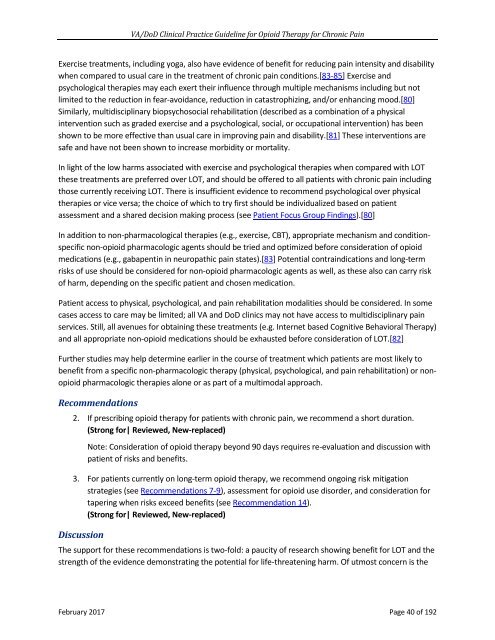VA/DoD CLINICAL PRACTICE GUIDELINE FOR OPIOID THERAPY FOR CHRONIC PAIN
2lfFhbO
2lfFhbO
You also want an ePaper? Increase the reach of your titles
YUMPU automatically turns print PDFs into web optimized ePapers that Google loves.
<strong>VA</strong>/<strong>DoD</strong> Clinical Practice Guideline for Opioid Therapy for Chronic Pain<br />
Exercise treatments, including yoga, also have evidence of benefit for reducing pain intensity and disability<br />
when compared to usual care in the treatment of chronic pain conditions.[83-85] Exercise and<br />
psychological therapies may each exert their influence through multiple mechanisms including but not<br />
limited to the reduction in fear-avoidance, reduction in catastrophizing, and/or enhancing mood.[80]<br />
Similarly, multidisciplinary biopsychosocial rehabilitation (described as a combination of a physical<br />
intervention such as graded exercise and a psychological, social, or occupational intervention) has been<br />
shown to be more effective than usual care in improving pain and disability.[81] These interventions are<br />
safe and have not been shown to increase morbidity or mortality.<br />
In light of the low harms associated with exercise and psychological therapies when compared with LOT<br />
these treatments are preferred over LOT, and should be offered to all patients with chronic pain including<br />
those currently receiving LOT. There is insufficient evidence to recommend psychological over physical<br />
therapies or vice versa; the choice of which to try first should be individualized based on patient<br />
assessment and a shared decision making process (see Patient Focus Group Findings).[80]<br />
In addition to non-pharmacological therapies (e.g., exercise, CBT), appropriate mechanism and conditionspecific<br />
non-opioid pharmacologic agents should be tried and optimized before consideration of opioid<br />
medications (e.g., gabapentin in neuropathic pain states).[83] Potential contraindications and long-term<br />
risks of use should be considered for non-opioid pharmacologic agents as well, as these also can carry risk<br />
of harm, depending on the specific patient and chosen medication.<br />
Patient access to physical, psychological, and pain rehabilitation modalities should be considered. In some<br />
cases access to care may be limited; all <strong>VA</strong> and <strong>DoD</strong> clinics may not have access to multidisciplinary pain<br />
services. Still, all avenues for obtaining these treatments (e.g. Internet based Cognitive Behavioral Therapy)<br />
and all appropriate non-opioid medications should be exhausted before consideration of LOT.[82]<br />
Further studies may help determine earlier in the course of treatment which patients are most likely to<br />
benefit from a specific non-pharmacologic therapy (physical, psychological, and pain rehabilitation) or nonopioid<br />
pharmacologic therapies alone or as part of a multimodal approach.<br />
Recommendations<br />
2. If prescribing opioid therapy for patients with chronic pain, we recommend a short duration.<br />
(Strong for| Reviewed, New-replaced)<br />
Note: Consideration of opioid therapy beyond 90 days requires re-evaluation and discussion with<br />
patient of risks and benefits.<br />
3. For patients currently on long-term opioid therapy, we recommend ongoing risk mitigation<br />
strategies (see Recommendations 7-9), assessment for opioid use disorder, and consideration for<br />
tapering when risks exceed benefits (see Recommendation 14).<br />
(Strong for| Reviewed, New-replaced)<br />
Discussion<br />
The support for these recommendations is two-fold: a paucity of research showing benefit for LOT and the<br />
strength of the evidence demonstrating the potential for life-threatening harm. Of utmost concern is the<br />
February 2017 Page 40 of 192


